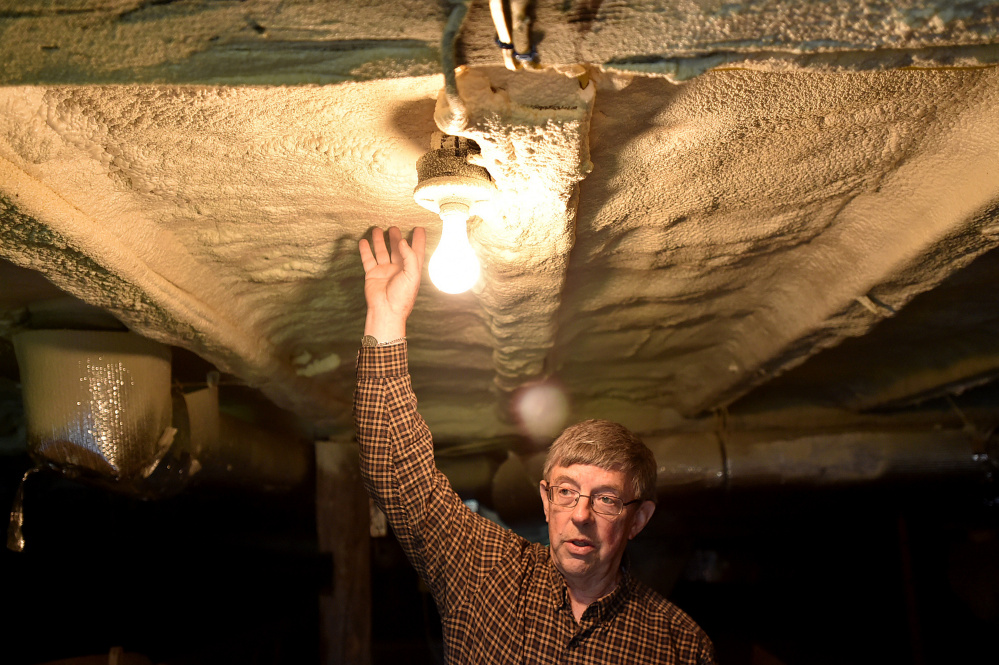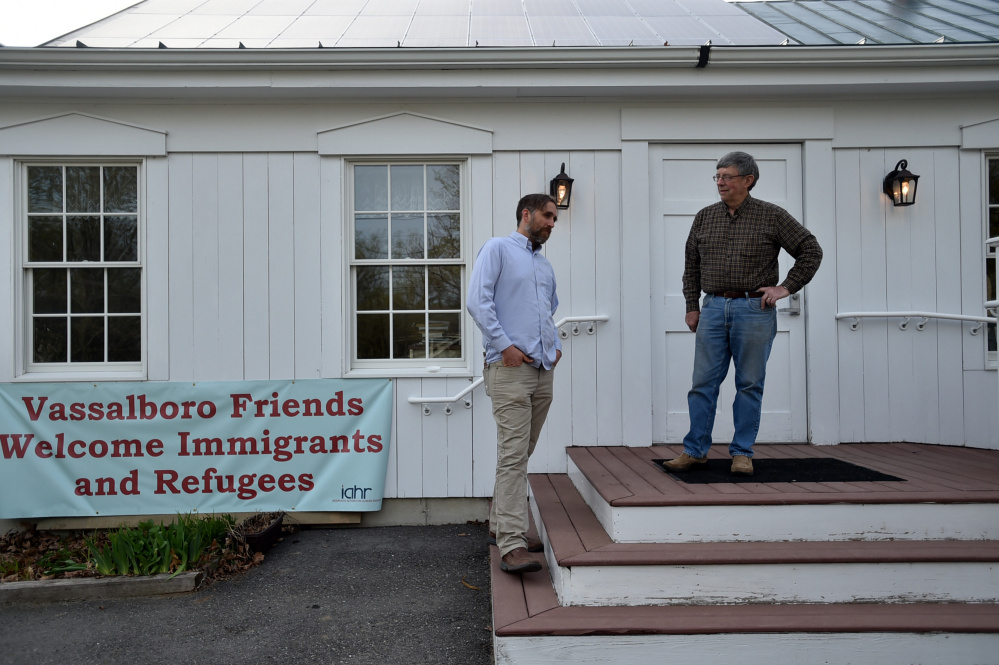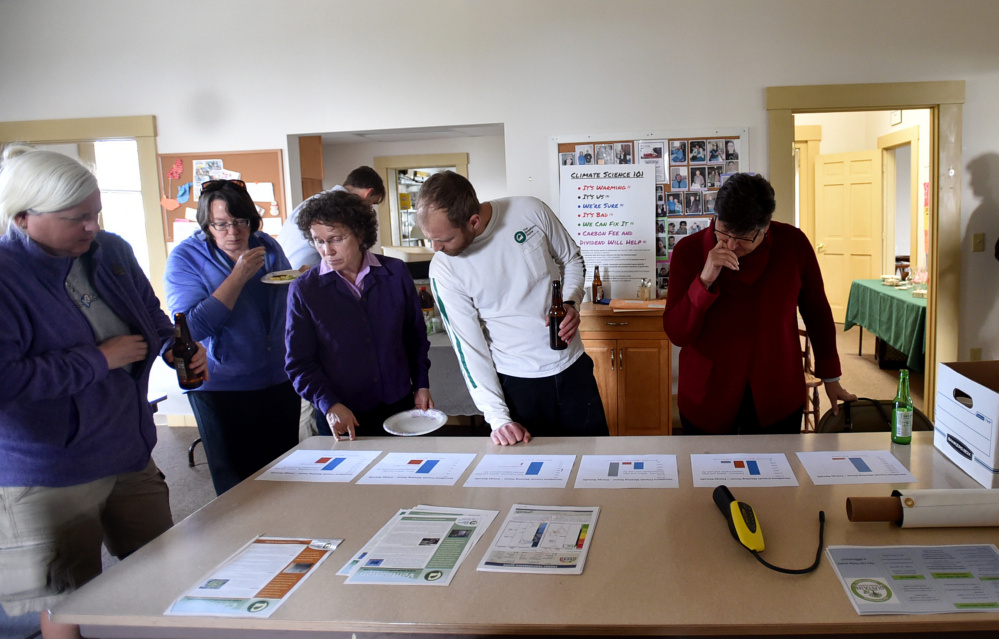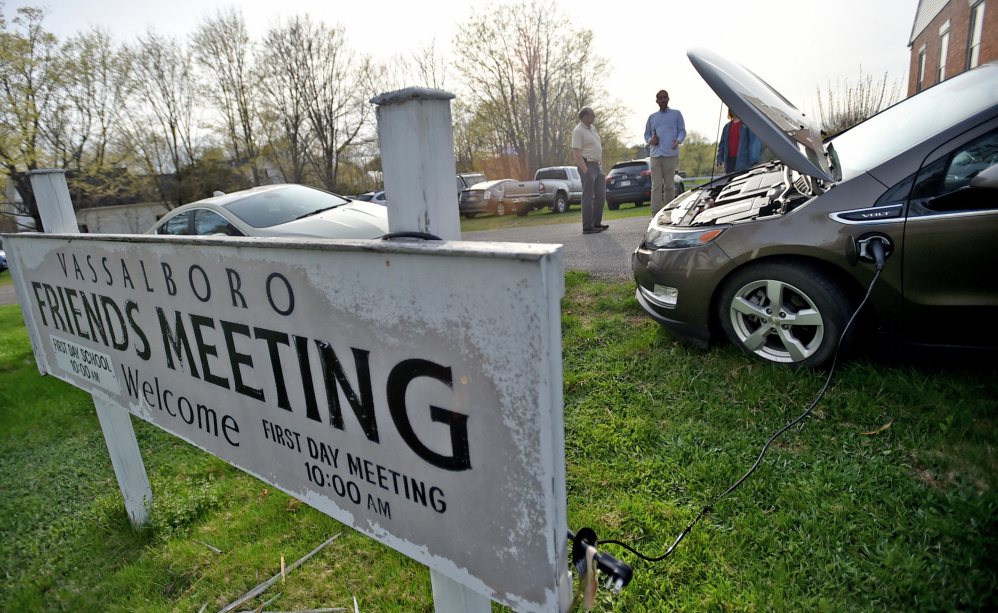VASSALBORO — It’s a fairly nondescript house on South Stanley Hill Road, an old house overlooking a cemetery on a street made up of old houses. Aside from the sign letting passers-by know it’s the Vassalboro Friends Meeting House, what really sets it apart from all the other houses in the neighborhood are the solar panels attached to the roof.
But the solar panels are just one part of a $40,000 effort by the Quaker congregation to become more energy-efficient. There’s more to be seen inside — and below — the meeting house. On Thursday, they opened their doors to kick off a conversation about energy.
John Reuth, the former chairman of the energy team at the Sustain Mid Maine Coalition and a member of the meeting, said the Friends are now a full year into their efforts to become more energy-efficient, and the results have been noticeable.
The Quakers have been meeting in the Vassalboro house since 1833, and Reuthe said it wasn’t exactly “weather-tight,” especially in the winter. It used electricity, oil and propane for power and heat before the congregation decided to go through a “greening” process.
That meant weatherization and finding alternative heat sources, Reuthe said.
So in January 2016, the congregation installed 33 photovoltaic solar panels on the roof. But it didn’t stop there. The group installed heat pumps, which move heat from outside into a home during the heating season and provide cooling and dehumidification in the summer. The group added window inserts they had built using shrink film and window dressers. But probably the most effective weatherization effort occurred beneath the floorboards.
Reuthe said the congregation had an energy audit conducted, in which thermal cameras were used to see where cold air was coming into the building. The basement was pegged as a major culprit, and Bo Jesperson, from The Breathable Home, decided the envelope for heat preservation would be from the floorboards up.
The basement, an unfinished room with piles of old stones on top of natural earth on either side of the room, was treated with a sealing foam across the ceiling to keep air from passing through. This has also helped prevent mildew in the house’s library, where a number of rare books are kept. The foaming of the basement and adjacent crawlspace not only helped keep the cold out, but also improved the quality of the air, Reuthe said.
Weatherizing the house cost $14,000, Reuthe said, and the Friends expect a return on that investment in less than six years. During a tour of the house on Thursday, Jesperson said that return typically can take up to 10 years, so the congregation’s return was fairly remarkable.
Reuthe said oil is no longer needed to provide heat to the meeting house. Without insulating the walls and just by weatherizing the envelope and adding the solar panels, Reuthe said, the meeting has decreased its energy consumption by more than 60 percent.
“If you can get your money back in five years and be comfortable, it makes a lot of sense,” Reuthe said.
SOLARIZE MID MAINE
The tour of the meeting house was one of four events being put on by Solarize Mid Maine. The remaining events include two solar home tours — one at 62 Axtell Drive in Oakland and the other at 169 Western Ave. in Waterville — and a solar business tour at the 93 Main Coffee Shop in Unity.
Solarize Mid Maine is a project of the Sustain Mid Maine Coalition, a nonprofit organization sponsored by the city of Waterville, the Kennebec Valley Council of Governments, Inland Hospital and a host of other organizations. Sustain Mid Maine Coalition promotes energy conservation and the use of alternative energies, among other pursuits.
The mission of Solarize Mid Maine is to lower the cost of solar energy by bringing people in the region together. Property owners who sign a contract before July 29 with Insource Renewables, the installation partner of the organization, receive group pricing, reducing costs for themselves and their neighbors.
Vaughan Woodruff, president of Insource Renewables in Pittsfield, said, “The more people who buy lowers the price for everyone,” since overall costs can be reduced by having crews work on multiple arrays in an area.
Vaughan estimated the group-buying program reduces costs up to 5 percent for buyers. Last year, he said, 18 solar array systems were installed under the agreement. Insource Renewables installed the solar units at the Vassalboro Quaker meeting house. But after July 29, the bulk discount is no longer available.
“The goal of a Solarize program is to cluster sales and installation to gain efficiencies that reduce costs to everyone,” Woodruff said. “A slower trickle that is spread out over time does not gain those efficiencies, thus the deadline.”
Solarize Mid Maine, which combines the efforts of about 150 people, is similar to Solarize Freeport in southern Maine, where about 40 households entered into a purchasing agreement with Insource Renewables, a company of 12 people. The Solarize Freeport customers saved around 10 percent on their solar power systems by buying in bulk.
And decreasing incentives have motivated more people to buy this year, Woodruff said.
The state’s solar policy is governed by the Maine Public Utilities Commission. A recent recommendation by the PUC could spell trouble in the future for homeowners and small businesses that might rely on incentives to switch to solar. Under the proposed rules, homeowners who have already installed solar panels would be compensated for the power they produce and export to the grid at a full retail rate for 15 years; but after the calendar hits 2018, those who install solar panels would see the credit gradually reduced over time. While current solar owners get the 1-to-1 credit for every kilowatt hour exported to the grid, those values are set to decrease — first to a 90 percent credit, then to an 80 percent credit, and so on.
The solar array at the meeting house in Vassalboro operates through the current net metering system, a billing mechanism that credits solar energy system owners for the electricity they export to the grid. Currently, for every kilowatt hour sent to the grid, a client receives an equal value of credit back.
Woodruff said Solarize Mid Maine looks to help interested buyers get in ahead of the changing PUC rules.
LARGER-SCALE PROJECTS
Central Maine is already home to the largest municipal solar array in Maine. The 26,000-panel array spanning roughly 22 acres in the Madison Business Gateway generates enough electricity to satisfy the needs of about 20 percent of Madison Electric Works customers. Superintendent Calvin Ames has said that on a sunny day, the farm will meet the needs of “100 percent” of the utility’s customers — about 3,000 homes and small businesses, excluding Backyard Farms. The array was constructed by Ohio-based IGS Solar, and Madison Electric Works purchases all the energy it produces.
Fairfield and Clinton have both been eyed for farms that would generate enough power for 6,000 out-of-state homes combined and that would create more than 200 jobs locally. Ranger Solar, based in Yarmouth, is planning projects in Fairfield and Clinton to generate 20 megawatts of power each, and the generated power will be sold to Connecticut. The farms, the exact locations of which have not been released, are each expected to cost around $20 million. Before sites are finalized, the Maine Department of Environmental Protection needs to investigate the sites.
Ranger Solar also is planning to bring a utility-scale solar farm to Farmington that could break ground in 2018 and eclipse the size of any solar installation now operating in Maine.
Woodruff said the Friends’ array was too small to have been constructed through a power purchasing agreement, such as those mentioned, in which the array is owned by a private company and electricity is purchased from that company.
But Reuthe said he hopes the Quaker meeting house inspires others to take similar steps toward energy efficiency. A number of the houses on South Stanley Hill Road, where the meeting house sits, are old, have dirt basements, lose heat and have lesser air quality. While the cost may seem a lot up front — $14,000 to weatherize and $26,000 for the solar array — Reuthe said the small congregation was able to raise money and secure grants. They still use propane for hot water, but Reuthe said the meeting house no longer relies on oil for heat.
Colin Ellis — 861-9253
cellis@centralmaine.com
Twitter: @colinoellis
Send questions/comments to the editors.







Comments are no longer available on this story